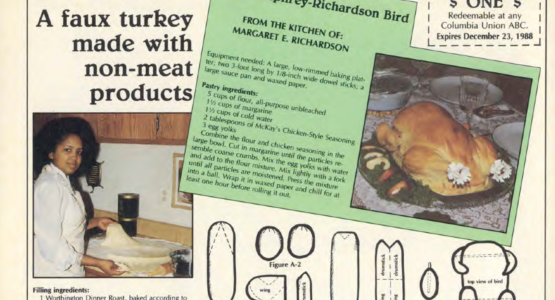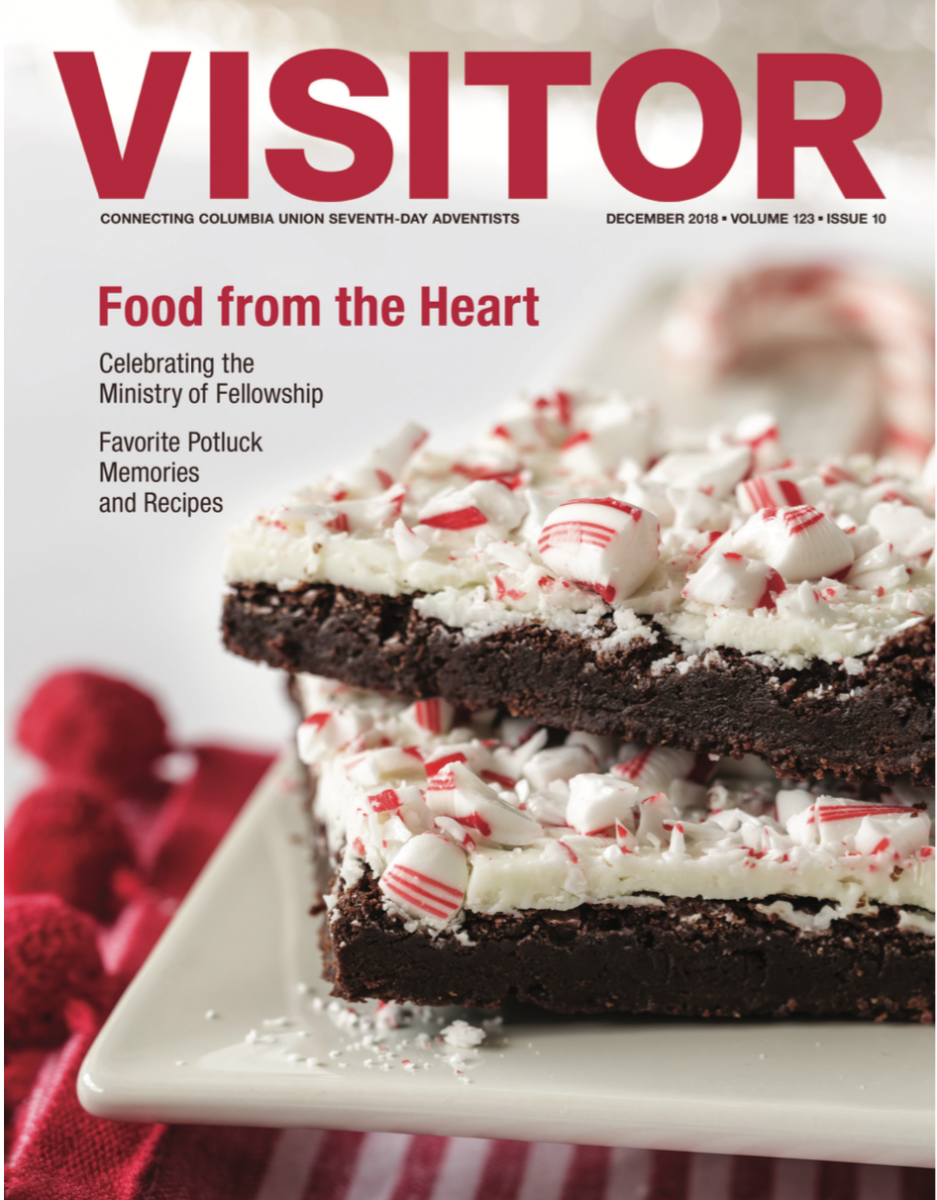
Recipe for Faux Turkey Made With Non-Meat Products
 We originally published Margaret E. Richardson's recipe for the Humphrey-Richardson Bird in the November 15, 1988 issue of the Visitor. We hope you'll enjoy it again!
We originally published Margaret E. Richardson's recipe for the Humphrey-Richardson Bird in the November 15, 1988 issue of the Visitor. We hope you'll enjoy it again!
Equipment needed: A large, low-rimmed baking platter; two 3-foot long by 1/8 inch dowel sticks; a large sauce pan and waxed paper.
Pastry ingredients:
- 5 cups flour, all-purpose unbleached
- 1 1/2 cups of margarine
- 1 1/2 cups of cold water
- 2 tablespoons of McKay's Chicken-Style Seasoning
- 3 egg yoks
Combine the flour and chicken seasoning in the large bowl. Cut in margarine until the particles resemble coarse crumbs. Mix lightly with a fork until all particles are moistened. Press the mixture into a ball. Wrap it in waxed paper and chill for at least one hour before rolling it out.
Filling ingredients:
- 1 Worthington Dinner Roast, baked according to directions and set aside.
- 1 large Worthington Smoked Turkey-style roll (approximately 4 pounds).
Stuffing:
- Pepperidge Farm stuffing (enough for a 20-pound turkey) Note: Use the crushed, seasoned variety for smooth modeling.
- 1 cup of chopped onions
- 1 cup of chopped celery
- ¼ cup of soy sauce
- 1/2 stick of margarine
- 2 packets of George Washington Broth, onion-flavored seasoning
Sauté vegetables in a large saucepan using margarine. Add other stuffing ingredients with the recommended amount of hot water given in the package directions. (Must result in a slightly sticky mixture for ease in molding the turkey shape.) Mix in turkey-like protein scraps from carving after following the carving instructions below.
Carving the Worthington turkey-style roll:
Note: This is the most important step in the correct formation of the faux turkey. Be careful in cutting and reading directions. Each roll of turkey-like product should yield six separate turkey parts: two turkey breasts, two drumsticks and two wings. Once these are carved by following directions specifically, all remaining scraps should be ground and mixed together with the prepared stuffing.
Step I. Turkey Breast
With a large knife, slice through the roll at the angles shown in Figure A-1. You should have two wedge-like pieces, as in Figure A-2. Set these aside.
Step II. Drumsticks and Wings
Turn the now wedge-edged roll sideways and make a V-shaped cut approximately two inches deep in the top middle, as shown in Figure A-3. Remove the V-shaped piece, then cut down through the middle of the whole roll starting at the bottom point of the V-shaped cut. Next, cut the two long, slender pieces in half as shown in Figure A-4, keeping in mind what part will come from each piece.
Once cut, carve and round off each of these turkey parts using a sharp knife. Keeping the flattened edge as the side that will meet the body of the turkey, see Figure A-5 for cutting and rounding shapes. Cut dowel sticks the length plus one inch of the drumsticks.
Note: The dowel sticks should be cleaned and their ends sanded before cutting. Insert a cut stick through the middle of each drumstick, as shown in Figure A-6.
Construction of Turkey:
Separate the dough, using one-third of it to completely cover each wing and drumstick. Roll out the dough on a lightly floured surface to about Vi inch thick. Use just enough pastry to cover each part totally, sealing the edges with water. Roll out the remaining dough onto a large sheet, also 1/4-inch thick, on a lightly floured board. Transfer this to the baking platter, keeping in mind that once construction has begun, the "turkey" must be baked and served from this point on—it cannot be moved easily. In the middle of the dough on the pan, place a slanted, round platform of stuffing (molded by hand) to support the baked Worthington Dinner Roast. The platform should be at least one inch thick, grading up to two inches high at the breast end of the turkey.
Place the dinner roast on the platform. Mound handfuls of stuffing, shaping the basic body of the turkey and completely covering the roast. Make indentations for placement of the turkey wings and drumsticks.
Place the breast pieces on the stuffing mound. Cover the body of the turkey with outer-laying dough, sealing edges and smoothing surfaces with water. Cut one dowel stick the width of the front of the turkey body plus two inches to support the drumsticks. Cut another dowel stick the width of the back of the turkey body plus two inches to support the wings.
With much care, and perhaps some extra help, place the turkey parts in their respective indentations on the main body. Push each dowel stick completely through the side of the drumstick and the body to the opposite drumstick, as shown in Figure B-1.
Do the same for placement of the wings. If additional support is needed, cut another dowel stick and place it beside the first in the same manner. The dinner roast inside is the main support.
Smooth edges, joinings and uneven dough with water. Use any additional dough to cover rough spots or stuffing showing through, sealing them with water.
Bake at 400 degrees until golden brown, approximately one hour. For a shiny, skin-like coating, brush with a mixture of one egg yolk and three tablespoons of water and place in the oven for seven more minutes. Garnish the platter as desired.
Bon appetit!
 Try these recipes featured in the December 2018 Visitor (Plus some extra recipes not included!):
Try these recipes featured in the December 2018 Visitor (Plus some extra recipes not included!):
- Bavarian Wiener Dish
- Blackberry Cake Top Recipe
- Cauliflower Patty Recipe
- Christine Greene's Carrot Casserole
- Curry Recipe
- Easy Chocolate Cake Recipe
- Grandma Sterner's Baked Bean Recipe
- Pancit Recipe
- Peppermint Bark (vegan option included)
- Traditional Maccaroni and Cheese Recipe
- Zucchini a la Mexicana Recipe

Add new comment